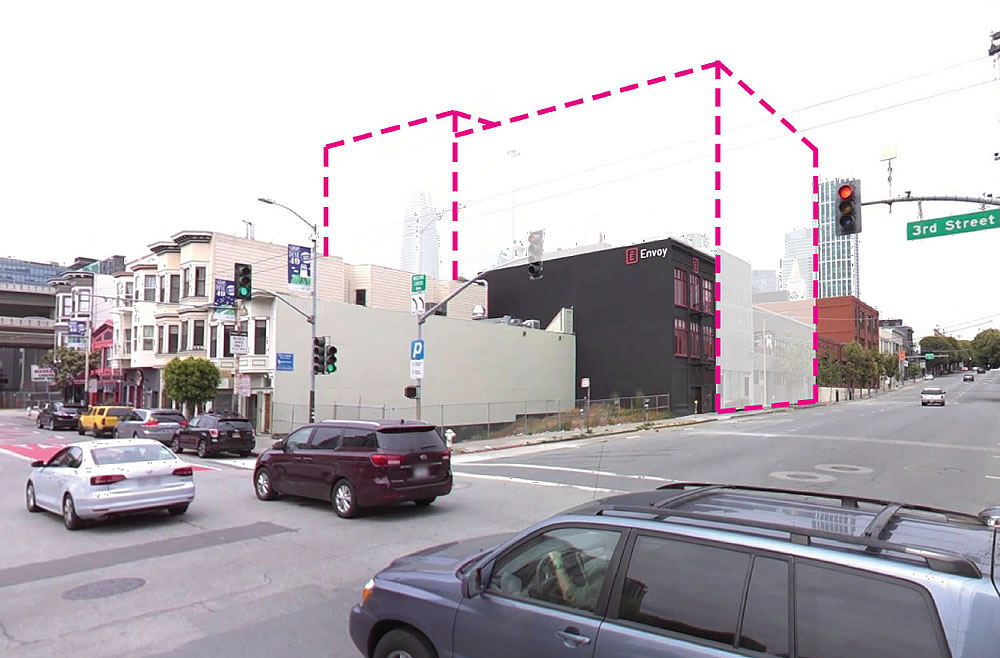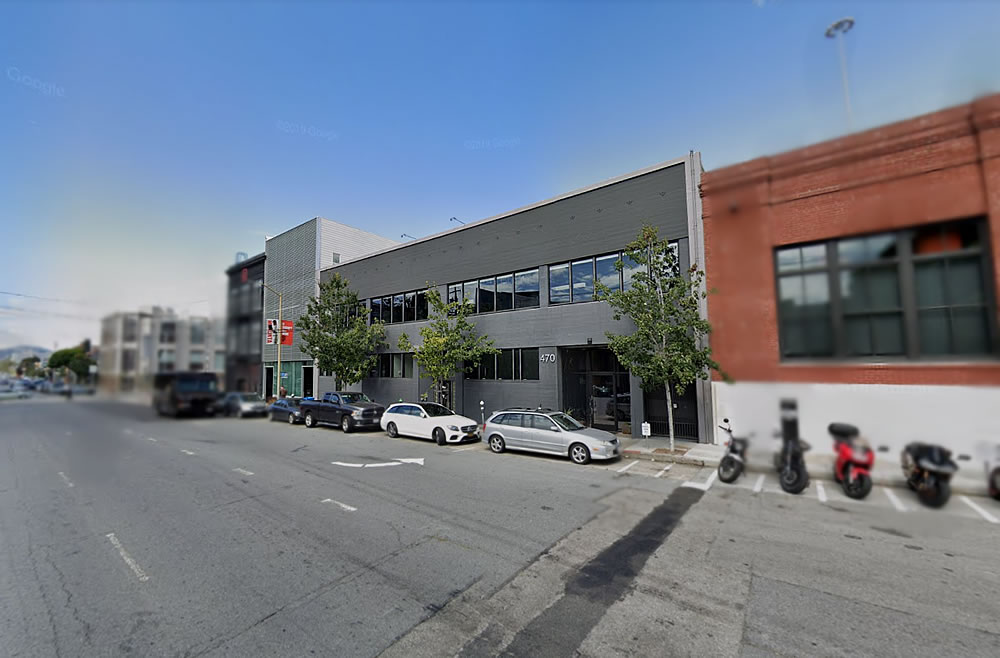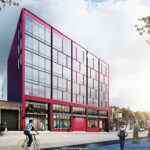Plans to raze the through-block building at 470-474 Bryant Street, along with the adjacent, but much smaller, modern-looking building at 482 Bryant, are in the works.
And as proposed by Aralon Properties, the property lines for the two parcels would then be redrawn to allow for two slightly offset, but equal-sized buildings to rise up to 85 feet in height across the Central SoMa site, with one 67,303-square-foot building fronting Bryant Street and the other fronting (77) Stillman behind.
As designed by Woods Bagot, each of the buildings would yield of six stories of new office space over a floor of “PDR” space and stacked parking for 17 cars.
And as the office component of each building has been designed to precisely measure 49,999 square feet, the project team would not need to secure an allocation from the City’s effectively depleted pool of allowable office developments that measure 50,000 square feet or more in order to proceed, assuming the proposed approach and lot line adjustments are approved.




Let’s assume San Francisco’s “Manifest Destiny” is replacement of surface lots and single story commercial buildings with 6-10 story buildings, along with the occasional skyscraper and the large scale Candlestick, Mission Rock, Potrero Yards etc. Residential as it stands today (notably in Richmond/Sunset) doesn’t change.
What decade do you think that is? 2100? We have a LOT of work to do in SOMA to replace these industrial buildings of the past.
btw, people always bag on the richmond about development and i agree with most, but the population density of inner richmond (94118) is higher than the city average (22K vs. 18K/sq mile) and higher than western SOMA (which is much more central to jobs/downtown/freeways, etc)
More like “Manifest Density” in this town.
Well played. I may use that in the future.
i think we all expect a softening demand for office space. Could this be rezoned for housing? 8-12 stories of residential would be perfect here.
It doesn’t need to be rezoned. Housing is already allowed at the heights you describe. In fact, the developer could get a ministerial (ie no CEQA, no process, non-discretionary, short turnaround) approval for a housing project there. However it seems, the property owner is choosing to propose office space, which is also allowed, but which requires more process.
Keep in mind that while many companies are liberalizing their remote work policies, this will be counterbalanced by the need to space out desks for employees who still come to the office. Bay Area tech firms facing a space crunch have been packing employees tighter and tighter for years, sometimes going as low as 125 square feet per employee. In a time of social distancing, that isn’t feasible.
The air and noise pollution from having this parcel so close to the freeway would also be a greater downside for housing.
Companies have been doing this because the business doesn’t work if they have to pay more than that. The startups I deal with are all adopting a work from home policy, they are going to be giving up space as leases expire.
My own office lease is up at the end of the year and I’ve started preparing to move out of it. We had our best months ever in April and May working from home and I’m having trouble justifying an office expense that appears to be a drain on productivity.
So… office development won’t pencil out because the rent for offices is too high? This is “nobody goes there anymore, it’s too crowded” logic.
And, due to social distancing, the cost per square foot per employee will surge. SF office rents are among the highest in the country and under the new paradigm most companies will not be able to afford to be in SF. This probably will not pencil as office space but, as someone above mentioned, it could be built as housing instead. There is the potential for a large shift of jobs out of SF – tens of thousands – and many approved but not under construction office projects will probably not get built. Proposing new office space in SF is rather silly at this point..
While there are of course no guarantees about vaccine development, I think it’s incredibly short-sighted and evidence-less to suggest that office use and office development is dead for an extended period of time, let alone “ever”, in SF and other major urban centers. The people who are looking at the same world as you and putting big money at stake don’t see it the same way, and I agree with them.
Short term (0-1 or 2 years), yes it is a risky proposition to break ground on a new office building in SF, and I wouldn’t want to be the one completing a building in the next 12 months. But beyond that, the good money still says that office space in SF and other highly desirable cities is still a good bet. I think the issue, as some have pointed out, might be an exacerbation of the existing trends of big, deep-pocketed tech firms, pricing out everyone else. As they want to give their employees more space to spread out, they may gobble up even more space. I know for a fact that Salesforce, among other firms, is very recently (ie post-pandemic onset) looking to take on even more big space downtown, as one anecdote.
One possible commercial real estate and economic diversification silver lining is that biotech/life science R&D may get a bigger foothold in SF and some prospective office buildings could become labs instead. The benefit of that being that it’s likely a bunch of money is going to start getting poured into life science, and labs don’t need Prop M office approvals to get built, unlike offices.
One of the vaccines will work, although more likely to have efficacy that doesn’t provide 100% protection. Antibodies from Lilly or Regeneron will likely reduce symptoms/hospitalization times. I can see working in office having ability to be normal in 2022, but many people will be used to/ choose to stay with remote work. Office space definitely not dead but think demand at current level will take years
agreed. Plus this project is just getting proposed so it is years out from completion. That they are proposing a creative plan to get around the Prop M allocation also says they don’t think anyone in the pipeline is going to give up those projects.
And that hole in the ground corner lot still stays vacant as it has for the last few decades at Bryant and 3rd street as shown the street scene images. What is the story behind that space?
While I don’t know the story behind how it became vacant, I’ll bet it hasn’t been developed because it’s way too small (and development way too expensive) for anything to pencil out.
That empty corner does seem rather easy to develop, as whatever was there was unlikely to be big enough to have created much pollution or a foundation that needs razing.
Maybe if we someday get Bryant St enhanced like Folsom is – with bike lanes, larger sidewalks – the value will increase to something that will pencil out.
“That empty corner does seem rather easy to develop, as whatever was there was unlikely to be big enough to have created much pollution or a foundation that needs razing.”
Lol it’s literally a hole in the ground. There’s no foundation of any kind remaining. It was tagged after Loma Prieta and demolished. The only foundation consists of trash thrown over the fence, or the fence itself after getting kicked in by the local winos at South Park.
Last time I spoke with the owner, he was holding out for a price that didn’t make sense with reality. I tried to bring him a buyer to redevelop the lot, but did not materialize
482-486 was just built in 2015… how can SF planning be so awful that demolishing a 5 year old building becomes economically feasible?
Keep in mind that Planning has since up-zoned the parcel for another 20 feet in height and the proposed development would actually double the height of what was built.
Regardless, it’s a somewhat unique situation and clever approach if approved, with the value of what was built dwarfed by the potential to morph the existing 2,299 and 14,941 square foot parcels into two distinct 8,622 square foot sites.
What a town! Get the trucks rolling.
That empty corner lot was formerly occupied by a building that was red-tagged after the 1989 earthquake and torn down.